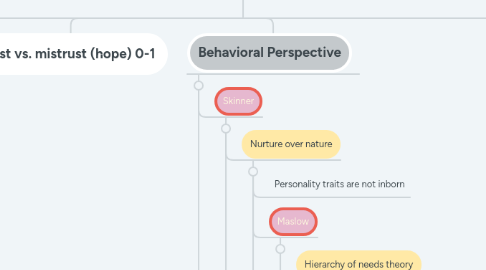
1. Sanguine (red-heart)
2. Historical Perspective
2.1. Franz Gall
2.1.1. Proposed that: distance betweenbumpson the skull reveal personal traits
2.1.1.1. Phrenology
2.2. Hippocrates
2.2.1. Human behaviors are based on4temperaments
2.2.1.1. Choleric (yellow-liver)
3. Melancholic (black-liver)
4. PsychodynamicPerspectiveFreud
4.1. Stages of Psychosexual Development
4.1.1. Oral 0-1
4.1.2. Anal 1-3
4.1.3. Phallic (genitals) 3-6
4.1.4. Latency (None) 6-12
4.1.5. Genital 12+
4.2. Unconscious
4.2.1. EGO
4.2.1.1. Id & Superego
4.3. Defense Mechanisms
4.3.1. Denial
4.3.2. Displacement
4.3.2.1. Low: uncooperative
4.3.3. Projection
4.3.4. Reaction Formation
4.3.5. Repression
4.3.6. Sublimation
5. Incongruence can lead to maladjustment
6. Neo-Freudians
6.1. Adler
6.1.1. Social tasks
6.1.1.1. Occupational tasks
6.1.1.2. Societal tasks
6.1.1.3. Love tasks
6.1.2. Inferiority complex
6.1.3. Superiority complex
6.2. Erikson
6.2.1. Interpersonal relationships are more important tnat sexual energy
6.2.2. Personality is developed throught your life
6.2.3. Stages of Psychosocial crisis
6.2.3.1. autonomy vs. shame (will) 1-3
6.2.3.2. initiative vs. guilt (purpose) 3-5
6.2.3.2.1. industry vs. inferiority (competency) 5-12
6.2.3.2.2. identity vs. role confusion (fidelity) 12-18
6.2.3.3. intimacy vs. isolation (love) 18-40
6.2.3.4. generativity vs. stagnation (care) 40-65
6.2.3.5. Ego integrity vs. despair (wisdom) 65+
6.3. Jung
6.3.1. The collective unconscious is a universal version of the unconscious.
6.3.1.1. Mental patterns or memory traces
6.3.1.1.1. These acestral memories are called archetypes
6.3.2. 2 attitudes or approaches towards life
6.3.2.1. extroversion
6.3.2.2. introversion
6.3.2.3. The focus of analytical pshycology is on working to balance opposing forces of conscius and unconscious thought and experience within one´s personality.
6.4. Horney
6.4.1. Copying styles
6.4.1.1. Moving towards people
6.4.1.1.1. Afiliation and dependence
6.4.1.2. Moving against people
6.4.1.2.1. Agression and manipulation
6.4.1.3. Moving away from people
6.4.1.3.1. Detachment and isolation
6.4.2. Each individual has the potential forself-realization.
7. We experience incongruence when thereisadiscrepancy between our ideal andattitude
8. Behavioral Perspective
8.1. Skinner
8.1.1. Nurture over nature
8.1.1.1. Personality traits are not inborn
8.1.1.2. Maslow
8.1.1.2.1. Hierarchy of needs theory
8.1.1.3. Behave on prior learning
8.1.2. Behave in a certain way
8.1.2.1. Theory of birth order
8.1.2.1.1. The middle ones will help both get along.
8.1.2.1.2. The youngest will be spoiled.
8.1.2.2. Personality develops over our entire life not only the first few years
8.1.2.3. Increasing the ones that lead to positive results
8.2. Bandura (social-cognitive)
8.2.1. Reciprocal Determinism
8.2.2. Observational Learning
8.2.2.1. Personality is shaped by actions
8.2.3. Learning new behavior patterns when we see others performing them.
8.2.4. Decrease the ones that don´t
8.2.5. Self-Efficacy
9. Humanistic Approaches
9.1. Carl Rogers
9.1.1. Divided the self
9.1.1.1. Ideal: the person you would like to be
9.1.1.2. Real: the person you actually are
9.1.2. We experience congruence when our thoughts about our real and ideal self are similar
10. Biological Approaches
10.1. Minessota
10.2. Somatoypes
10.2.1. Endomorph
10.2.1.1. Average-size bones, solid torso, low levels of fat, very sociable and fun
10.2.2. Mesomorph
10.2.2.1. Equilibrates body of muscles and bones, athletic. Very energetic and like sports
10.2.3. Ectomorph
10.2.3.1. Tall, thin. Very emotional, suffer social problems
11. Rationalization
12. Regression
13. Traits Approach
13.1. The Five Factor Model (OCEAN)
13.1.1. Oppennes
13.1.1.1. High: curious, independent.
13.1.1.2. Low: practical, conventional
13.1.2. Conscientiousness:
13.1.2.1. High: hardworking, organized
13.1.2.2. Low: impulsive, careless
13.1.3. Extroversions
13.1.3.1. High: outgoing, warm
13.1.3.2. Low: quite, reserved
13.1.4. Agreebleness
13.1.4.1. High: helpful, empathetic
13.1.5. Neuroticism
13.1.5.1. High: anxious, unhappy
13.1.5.2. Low: calm, secure
14. Cultural Understanding
14.1. Universal
14.1.1. Some personality traits dont depend on culture.
14.2. Culture-specific
14.2.1. Asian: collectivism
14.2.2. Central & South American: openness
14.2.3. European: neuroticism
14.3. Study Approaches
14.3.1. Cultural-comparative
14.3.2. Combines
